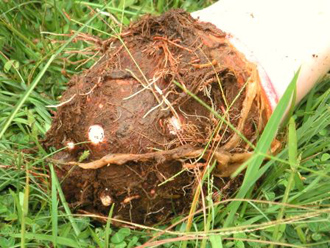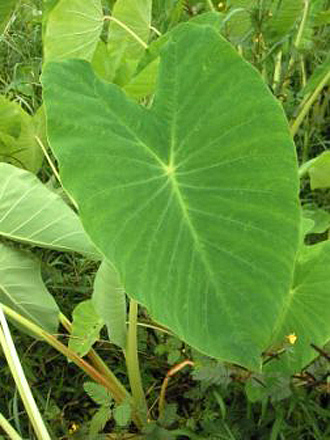POI
a sacred, life giving food
sustaining living beneficial organisms
that transform the nutrients contained in taro
into a higher form of energy which nourishes
the human body, heart and soul
Taro is an ancient food and was the staff of life for the Hawaiian people. For centuries, taro
(Colocasia esculenta) has been a nutritious staple food for Hawaiians and many other Polynesian peoples throughout the Pacific Rim. The Hawaiian’s lived primarily on poi (fermented taro), sweet potatoes, fish, seaweed, coconut, green vegetables and fruit. Their diet contained no grains or animal milk. Very few food staples exist anywhere in the world that can be considered hypoallergenic, are rich in calcium, potassium, phosphorus, magnesium, a good source of B vitamins, contain vitamins A and C, minerals, and a small measure of high quality, easily digestible protein. Kalo, or Taro, as it is more commonly known, is not only nutritious but is considered to be a beneficial carbohydrate food that provides a high fiber, slow-release energy food source that may be beneficial for the more than 100 million people worldwide that suffer from diabetes.
 |
Cooked taro corm that is blended, mixed with water, and fermented is called “poi”. The making of poi is indigenous to Hawaii and is the only place in the world where this ancient practice of food preparation is still found as a mainstream cultural and spiritual experience. Taro is considered the most sacred of all foods; the ancestry of the Hawaiians is traced back to the taro plant and is thought of as an intimate family member. The use of poi as a staple is believed to have led Captain James Cook and other early western visitors to Hawaii to describe native Hawaiians as being an exceptionally healthy people, characterized by splendid physique and good teeth. (
Nutrition and Physical Degeneration, Weston A. Price, D.D.S.) Scientific studies have substantiated this observation. In Hawaiian culture and around the world, poi can be used as an excellent substitute for dairy, soy, grain and gluten products. The digestibility of taro starch has been estimated to be 98.8 percent and is far superior over other starchy foods. Poi may be successfully used by people with food allergies, food sensitivities, autism, celiac disease and various other health conditions that require a low-allergenic, easily digestible, food source. Poi is so digestible that it have been used as an infant food and even used for premature infants for generations.
Studies have shown that poi is a hypoallergenic, naturally fermented, energy dense, carbohydrate staple that contains heat resistant lactic acid bacteria (LAB). Despite having an acidic pH, which enhances food safety, poi and taro are considered alkaline foods because the alkaline-forming elements (Na, K, Ca, Mg) that are present exceed the acid-forming elements (S, P, Cl). Thus, poi acts as an alkalinizing food in the body rather than an acidifying food. This characteristic helps explain why poi is regarded as a food that can prevent dental caries and why it is highly digestible, and suggests its use in offsetting the tendency toward acidity in advanced cancer patients.
Food Fermentation
ALCHEMY….
The mystical and chemical changes (biological transformations)
that takes place
during the ancient practice of
fermentation.
Food fermentation is a process in which raw materials are converted to fermented foods by the growth and metabolic activities of desirable microorganisms. The
United Nations Rome Report of 1999 assessed that “Fermentation is the oldest known form of food biotechnology” and, fermentation of food causes “enrichment of nutritive content by microbial synthesis of essential vitamins and improving the digestibility of protein and carbohydrates.” There exists substantial tradition and science supporting the use of fermented and probiotic whole foods for the nourishment of humankind.
 |
On a personal level, I am passionate about fermentation as a living process. My house is usually literally bubbling with no less than a half dozen “experiments” transforming normal food into alchemical miracles that nourish my family. I am continually awed by the invisible intelligence that can create life and panoply of nutrients where there were few before. I feel like a co-creator in the life process. Guests to my home are brought tastes of my newest creations – kombucha, vegetable, herb or dairy kefir, sourdough, yogurt, mead, natto, kimchi, cultured crepes, villi, fil Mjolk, sauerkraut, ginger beer, the list goes on and on. But always, the glory in my heart and home is poi and we continually have some on hand to share.
While many of the benefits of fermented products may derive from the presence of viable probiotics in food, many important health benefits of fermented foods that have been pasteurized or lacking live probiotic bacteria have been scientifically validated.
It was recently suggested by scientific research that it is not necessarily the presence of live culture that leads to possible beneficial effects of fermentation and probiotic bacteria.
Health benefits are derived from the numerous compounds that are created during fermentation and may include anti-allergenic effects; and anti-mutagenic properties along with conversion of food substrates biologically into vitamins, protein, essential amino acids and essential fatty acids. DNA from probiotic bacteria has been shown to limit epithelial pro-inflammatory responses
in vivo and
in vitro. Evidence also has been presented that intestinal epithelial cells may have evolved a strategy to distinguish between pathogenic, commensal and probiotic bacteria based upon a bacterial DNA fingerprint. While research is required to further substantiate these studies, this represents one potentially important mechanism by which fermentation may elicit immunomodulatory effects.
Indigenous people around the world usually ate fermented foods daily. Fermentation was a way of life in order to preserve food without refrigeration. Starter cultures were often considered family secrets, were guarded diligently and passed down to family members as heirlooms. Weston A. Price, DDS considered the use of fermented foods in indigenous societies as one of the reasons for their excellent health and longevity. Fermentation preserves food and makes it safer to consume. Fermented foods contribute to a healthy immune system, protect us from dangerous microorganisms, are easier to digest, remove toxins from foods, help us digest other foods, prevent disease and more.
Poi, an indigenous, traditionally fermented, culturally valuable food staple of the Hawaiians will provide people of all ages with solutions to their health challenges that they have been earnestly seeking.
Traditional Poi Cultures
True plant based cultures are rare. The microorganisms from naturally fermented poi are numerous and varied. Some of these poi cultures have been isolated and are being studied for their probiotic potential. The use of probiotic organisms is attractive because they enhance nutrition, are powerful immune supporting tools, have antimutagenic properties, anticarcinogenic properties, provide reduction in allergies and provide reduction in serum cholesterol concentration. Probiotics produce levels of acid that inhibit the growth of many spoilage organisms and/or potentially dangerous pathogens.[1] Further research has been conducted identifying specifically isolated poi cultures to have antiviral and anti-fungal potential. Based on previous studies reviewed by Brown and Valiere, poi appears to have a beneficial affect on health and therefore meets the definition of a probiotic.
Many other benefits of the application of these poi cultures are being researched to scientifically validate the potential of these powerful plant-based cultures.
Ho’ola! (To health!)
Pamela’s fifteen-year ongoing apprenticeship with the traditional Hawaiian healer, Papa Henry Auwae, furthers her quest as a student of Hawaiian Medicine. She continues her studies in La’au Lapa’au (Hawaiian Medicine and Spirituality) in addition to being the founder and President of Taro Dream Inc., developer of Taro Dream® and POI BABY®, exotic and delicious poi-based products especially geared to those with digestive difficulties. Poi is a life-giving food with potentially powerful probiotic and nutritional benefits, but traditional poi also has a short shelf life and sours quickly. Taro Dream, Inc. has overcome these obstacles through many years of hard work and grant funded research, making the benefits of traditional Hawaiian Poi available to everyone. Go to http://www.tarodream.com/ to learn more about this delicious life giving food. Pamela is sharing her Dream on the Big Island of Hawaii with her ohana, many plants, herbs and various fermenting creations.
References supplied upon request.
Pamela N. Day
Copyright © 2007 2008 2009 No reproduction by any means for distribution purposes allowed without the written permission of the author
These statements have not been evaluated by the Food and Drug Administration. This product is not intended to diagnose, treat, cure, or prevent and disease.

